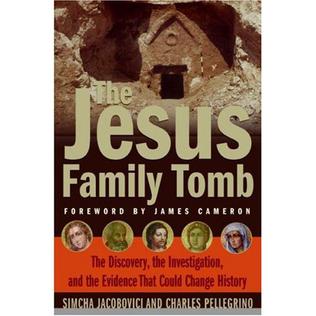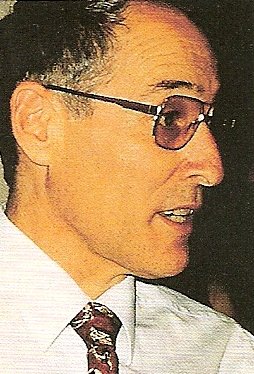
Shimon Gibson is a British-born archaeologist living in North Carolina, where he is a Professor of Practice in the Department of History at University of North Carolina at Charlotte. [1]

Shimon Gibson is a British-born archaeologist living in North Carolina, where he is a Professor of Practice in the Department of History at University of North Carolina at Charlotte. [1]
Gibson was the lead archaeologist excavating a wilderness cave he associated with John the Baptist in 2000 and later wrote The Cave of John the Baptist. [2] Such claim has been criticized by other scholars and, according to Hershel Shanks, "few, if any, scholars in Israel think this cave has anything to do with John the Baptist". [3] [4] [5] He later led a team that found a 10-line ritual cup at Mount Zion. [6] [7]
He is the editor of The Illustrated Dictionary & Concordance of the Bible [8] and was co-editor with Avraham Negev of the Archaeological Encyclopedia of the Holy Land. [9] In his The Final Days of Jesus: The Archaeological Evidence (2009) [10] he advanced the theory that Jesus was killed for acts of healing. [11]
Gibson has appeared in a number of biblical archaeology documentaries. [12]

The Dead Sea Scrolls, also called the Qumran Caves Scrolls, are a set of ancient Jewish manuscripts from the Second Temple period. They were discovered over a period of 10 years, between 1946 and 1956, at the Qumran Caves near Ein Feshkha in the West Bank, on the northern shore of the Dead Sea. Dating from the 3rd century BCE to the 1st century CE, the Dead Sea Scrolls include the oldest surviving manuscripts of entire books later included in the biblical canons, including deuterocanonical manuscripts from late Second Temple Judaism and extrabiblical books. At the same time, they cast new light on the emergence of Christianity and of Rabbinic Judaism. Almost all of the 15,000 scrolls and scroll fragments are held in the Shrine of the Book at the Israel Museum located in Jerusalem. The Israeli government's custody of the Dead Sea Scrolls is disputed by Jordan and the Palestinian Authority on territorial, legal, and humanitarian grounds—they were mostly discovered following the Jordanian annexation of the West Bank and were acquired by Israel after Jordan lost the 1967 Arab–Israeli War—whilst Israel's claims are primarily based on historical and religious grounds, given their significance in Jewish history and in the heritage of Judaism.
The historicity of the Bible is the question of the Bible's relationship to history—covering not just the Bible's acceptability as history but also the ability to understand the literary forms of biblical narrative. Questions on biblical historicity are typically separated into evaluations of whether the Old Testament and Hebrew Bible accurately record the history of ancient Israel and Judah and the second Temple period, and whether the Christian New Testament is an accurate record of the historical Jesus and of the Apostolic Age. This tends to vary depending upon the opinion of the scholar.

The James Ossuary is a 1st-century limestone box that was used for containing the bones of the dead. An Aramaic inscription meaning "Jacob (James), son of Joseph, brother of Yeshua" is cut into one side of the box. The ossuary attracted scholarly attention due to its apparent association with the Christian holy family.

The wedding at Cana is a story in the Gospel of John at which the first miracle attributed to Jesus takes place.

Biblical archaeology is an academic school and a subset of Biblical studies and Levantine archaeology. Biblical archaeology studies archaeological sites from the Ancient Near East and especially the Holy Land, from biblical times.

Meron is a moshav in northern Israel. Located on the slopes of Mount Meron in the Upper Galilee near Safed, it falls under the jurisdiction of Merom HaGalil Regional Council.

Geshur was a territory in the ancient Levant mentioned in the early books of the Hebrew Bible and possibly in several other ancient sources, located in the region of the modern-day Golan Heights. Some scholars suggest it was established as an independent city-state during the early Iron Age from the middle of the tenth century BCE, maintaining its autonomy for about a century until it was annexed in the third quarter of the ninth century by Hazael, the king of Aram-Damascus.

Hershel Shanks was an American lawyer and amateur biblical archaeologist who was the founder and long-time editor of the Biblical Archaeology Review.

The Dead Sea Scrolls Deception is a book by authors Michael Baigent and Richard Leigh. Rejecting the established scholarly consensus that the Dead Sea scrolls were the work of a marginal Jewish apocalyptic movement, and following primarily the thesis of Robert Eisenman, the authors argue that the scrolls were the work of Jewish zealots who had much in common with, and may have been identical to, the early followers of Jesus led by his brother James the Just. Their unconventional hypothesis provides a different version of the history of early Christianity and challenges the divinity of Jesus.

Pim weights were polished stones about 15 mm diameter, equal to about two-thirds of a Hebrew shekel. Many specimens have been found since their initial discovery early in the 20th century, and each one weighs about 7.6 grams, compared to 11.5 grams of a shekel. Its name comes from the inscription seen across the top of its dome shape: the Phoenician letters 𐤐𐤉𐤌.
James Daniel Tabor is an American Biblical scholar and retired Professor of Ancient Judaism and Early Christianity in the Department of Religious Studies at the University of North Carolina at Charlotte, where he taught from 1989 until 2022 and served as chair from 2004 to 2014. He previously held positions at Ambassador College, the University of Notre Dame (1979–85), and the College of William and Mary (1985–89). Tabor is the founder and director of the Original Bible Project, a non-profit organisation aimed to produce a re-ordered new translation of the Bible in English.

The Lost Tomb of Jesus is a pseudoarchaeological docudrama co-produced and first broadcast on the Discovery Channel and VisionTV in Canada on March 4, 2007, covering the discovery of the Talpiot Tomb. It was directed by Canadian documentary and film maker Simcha Jacobovici and produced by Felix Golubev and Ric Esther Bienstock, while James Cameron served as executive producer. The film was released in conjunction with a book about the same subject, The Jesus Family Tomb, issued in late February 2007 and co-authored by Jacobovici and Charles R. Pellegrino. The documentary and the book's claims have been rejected by the overwhelming majority of leading experts within the archaeological and theological fields, as well as among linguistic and biblical scholars.

The Jesus Family Tomb: The Discovery, the Investigation, and the Evidence That Could Change History (ISBN 0061192023) is a controversial book by Simcha Jacobovici and Charles R. Pellegrino published in February 2007. It tells the story of the discovery of the Talpiot Tomb on Friday March 28, 1980 and makes an argument that it is the tomb of Jesus Christ and his family.

Elisha Qimron is an academic who studies ancient Hebrew. He took his Doctor of Philosophy in 1976 at the Hebrew University of Jerusalem with the dissertation The Hebrew of the Dead Sea Scrolls.
The Biblical Archaeology Society was established in 1974 by American lawyer Hershel Shanks, as a non-sectarian organisation that supports and promotes biblical archaeology. Its current publications include the Biblical Archaeology Review, whilst previously circulating the Bible Review (1985–2005) and Archaeology Odyssey (1998–2006). The Biblical Archaeology Society also publishes books about biblical archaeology aimed at a general readership. The Society has, for more than 45 years, run seminars and tours offering an opportunity to learn directly from archaeologists and scholars. It also produced videos (DVD) and CDs on archaeology and biblical archaeology.

Gat Rimon is a moshav in central Israel. Located in the Ono Valley in the Sharon plain between Ganei Tikva and Petah Tikva, it falls under the jurisdiction of Drom HaSharon Regional Council. In 2022 it had a population of 298.

Ze'ev Herzog is an Israeli archeologist, professor of archaeology at The Department of Archaeology and Ancient Near Eastern Cultures at Tel Aviv University specializing in social archaeology, ancient architecture and field archaeology. Ze’ev Herzog served as director of The Sonia and Marco Nadler Institute of Archaeology from 2005 to 2010, and has served as archaeological advisor to the Israel Nature and National Parks Protection Authority in the preservation and development of National Parks at Arad and Beersheba.

Jarmuth, Hebrew: יַרְמוּת, romanized: Yarmuṯ, was the name of two cities in Canaan.
The Book of Joshua lists almost 400 ancient Levantine city names which refer to over 300 distinct locations in Israel, the West Bank, Jordan, Lebanon and Syria. Each of those cities, with minor exceptions is placed in one of the 12 regions, according to the tribes of Israel and in most cases additional details like neighbouring towns or geographical landmarks are provided. It has been serving as one of the primary sources for identifying and locating a number of Middle Bronze to Iron Age Levantine cities mentioned in ancient Egyptian and Canaanite documents, most notably in the Amarna correspondence.

Lavnin (Hebrew: חורבת לבנין)(Arabic: خربة تل البيضة), is a late Bronze Age archaeological site situated in Israel's Adullam region, rising some 389 metres (1,276 ft) above sea level. The site lies 8 kilometres (5.0 mi) northwest of Beit Gubrin, and about 1 kilometer west-north-west of Khirbat Umm Burj, directly south of Nehusha.